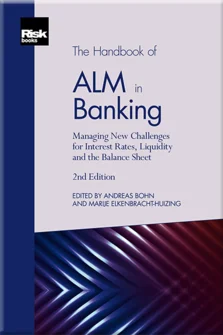Measuring and Managing Interest Rate and Basis Risk
Giovanni Gentili and Nicola Santini
Introduction
Bank Capital and Liquidity
ALM in the Context of Enterprise Risk Management
The New Basel Standards on IRRBB and Their Implications for ALM
Measuring and Managing Interest Rate and Basis Risk
The Modelling of Non-Maturity Deposits
Modelling Non-Maturing Deposits with Stochastic Interest Rates and Credit Spreads
Managing Interest Rate Risk for Non-Maturity Deposits
Replication of Non-Maturing Products in a Low Interest Rate Environment
Managing Mortgage Prepayment Risk on the Balance Sheet
Considerations for ALM in Low and Negative Interest Rate Environments
Credit Spreads
Hedge Accounting
Supervisory Views on Liquidity Regulation, Supervision and Management
Measuring and Managing Liquidity and Funding Risk
Managing Reserve Assets
Instruments for Secured Funding
Asset Encumbrance
Capital Management
A Global Perspective on Stress Testing
Reverse Stress Testing: Linking Risks, Earnings, Capital and Liquidity – A Process-Orientated Framework and Its Application to Asset–Liability Management
XVAs and the Holistic Management of Financial Resources
Optimal Funding Tenors
Funds Transfer Pricing in the New Normal
Balance-Sheet Management with Regulatory Constraints
Interest rate risk is the exposure of a bank’s financial situation to variations of interest rates. It is principally driven by the maturity mismatch embedded in the typical balance-sheet structure of banks.
This chapter will illustrate the main tools for measuring interest rate risk and provide hedging examples.
We first introduce the earnings and economic values approaches to measure interest rate risk, and then illustrate the regulatory treatment according to the Basel Committee framework before introducing basis risk.
Risk measurement techniques will be treated in depth, with a comparison of the relative strengths and weaknesses.
A framework for yield curve construction that takes into account the evolutions following the financial crisis (OIS discounting and importance of basis risks) is given. The chapter concludes with operational examples of hedging with swaps.11While credit spreads could also influence the net interest income and economic value of one bank, this chapter does not treat hedging of credit risk.
THE EARNINGS PERSPECTIVE AND THE ECONOMIC VALUE PERSPECTIVE
We can identify two possible perspectives for measuring and managing interest rate risk
Copyright Infopro Digital Limited. All rights reserved.
As outlined in our terms and conditions, https://www.infopro-digital.com/terms-and-conditions/subscriptions/ (point 2.4), printing is limited to a single copy.
If you would like to purchase additional rights please email info@risk.net
Copyright Infopro Digital Limited. All rights reserved.
You may share this content using our article tools. As outlined in our terms and conditions, https://www.infopro-digital.com/terms-and-conditions/subscriptions/ (clause 2.4), an Authorised User may only make one copy of the materials for their own personal use. You must also comply with the restrictions in clause 2.5.
If you would like to purchase additional rights please email info@risk.net











